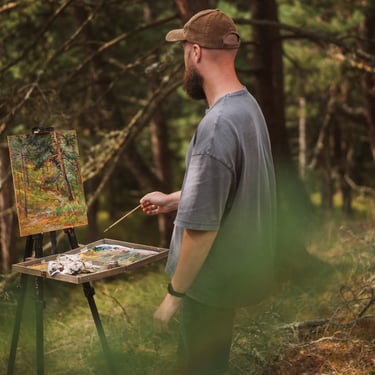
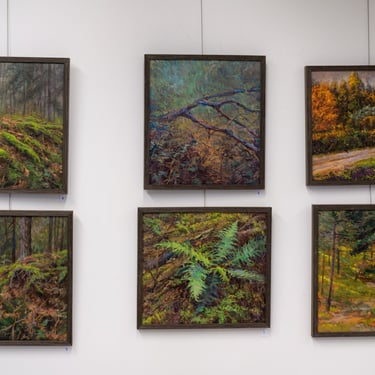
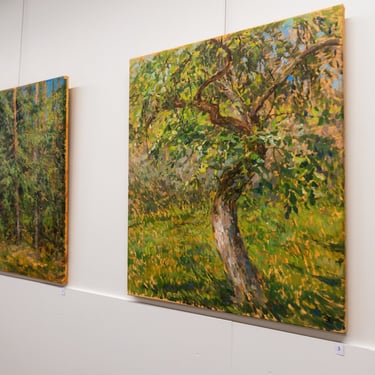
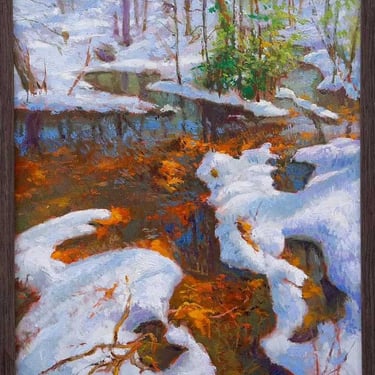
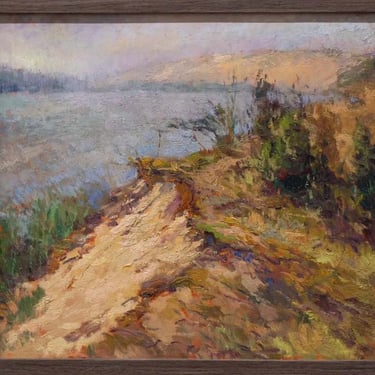

Plein air painter Justin Krasuckas
Download full PDF catalogue
What is Plein Air Painting?
Painting outdoors directly from the landscape, observing real light, color, and atmosphere.
Emphasizes immediacy, limited time, and working alla prima or in quick studies.
Rooted in 19th-century practice; used by Impressionists and modern plein-air societies to train observation and capture transient effects.
What does En Plein Air mean?
French for “in the open air.”
Refers to painting directly outside rather than in a studio.
Implies working from direct observation of natural light, weather, and environment to record immediate visual reality and atmosphere.
How is Outdoor Painting done effectively?
Choose a clear focal point and simplify values and shapes first.
Block in large masses rapidly, refine mid-tones, then add accents.
Use limited palette, fast brushes, and manage time for changing light; pack compact, efficient gear.
What makes Landscape Painting Outdoors unique?
Direct observation of changing light and weather produces immediacy and freshness.
Atmospheric perspective, color temperature shifts, and sensory impressions guide decisions.
The environment imposes time limits, leading to bolder brushwork and simplified compositions.
What should I know about Painting in Nature?
Be prepared: dress for weather, carry basic first aid, insect repellant, and permits if needed.
Work fast—light changes; perform small studies before committing to larger work.
Respect landowners and ecosystems; leave no trace and follow local rules.
What are essential Plein Air Techniques?
Rapid value blocking (big-to-small), alla prima layering, and direct color mixing.
Edge control: soft for atmosphere, hard for focal points.
Simplification, limited palette, and economy of brushstrokes to capture transient effects.
What Plein Air Art Supplies do I need?
Portable easel, pochade box or panel, travel brushes, limited paints, solvent or water, palette knife, rags, sketchbook, and sunscreen.
Bring seat, umbrella, and carrying case.
Keep kit compact and weather-resistant.
How to approach Plein Air Oil Painting?
Use a toned ground (imprimatura) to judge values quickly.
Block-in with thin, fast strokes; build paint using fat-over-lean.
Work alla prima for freshness; carry a small solvent cup and portable mahlstick for steadiness.
What are key methods for Plein Air Watercolor?
Plan light-to-dark washes; preserve paper whites.
Use wet-on-wet for atmosphere, wet-on-dry for edges and detail.
Carry a small travel palette, large brush for washes, and paper towels; sketch composition first.
What are top Plein Air Painting Tips?
Scout compositions beforehand; paint thumbnails.
Limit colors, paint big shapes first, and accept looseness.
Prioritize comfort and safety; photograph progress for studio refinement.
How to do Outdoor Art Painting well?
Simplify complex scenes to clear shapes and value planes.
Observe color temperature shifts and reflect them in mixes.
Practice fast sketching and iterative studies to build observational skills.
What defines Nature Painting Outdoors?
Faithful depiction of landscapes, flora, fauna, and atmospheric conditions from direct observation.
Focus on ecological detail, mood, and sensory truth instead of studio invention.
Often emphasizes seasonal light and natural rhythms.
Where can I find good Plein Air Workshops?
Look to regional plein-air societies, art schools, and museum-run programs.
Search community colleges, outdoor art festivals, and reputable instructors’ websites.
Read reviews and instructor bios; pick workshops emphasizing field practice and critique.
What are creative Plein Air Painting Ideas?
Paint time-of-day series of the same spot; micro-landscapes (moss, bark); urban plein air; weather studies.
Try limited-palette challenges or palette-knife-only pieces.
Combine quick sketches with studio expansions.
How to paint Natural Light Outdoors?
Note light direction, quality (hard vs. diffuse), and temperature; establish core shadow/value relationships.
Use warm lights/cool shadows (or vice versa) to show form and depth.
Observe reflected light and halo effects; paint the largest value shapes first.
What is special about Impressionist Painting Outdoors?
Focus on fleeting light, broken color, and loose brushwork to record sensory impressions.
Emphasizes color contrasts, complementary accents, and visible strokes instead of smooth modeling.
Often painted rapidly en plein air to seize transient moments.
What are the best Portable Easels for Plein Air?
Light, sturdy tripod easels and pochade-box easels excel—look for adjustable height, stability, and compactness.
Aluminum tripods, French-style pochades, and field/box easels are popular.
Choose based on paint medium (watercolor vs. oil), terrain, and travel needs.
What Plein Air Painting Equipment is essential?
Portable easel/pochade, panels or paper, travel palette, brushes, paints, solvent/water, stool, umbrella, and carrying case.
Small tools: mahlstick, clips, rags, sketchbook, and camera for reference.
Weather protection and permits where required.
How to succeed in Painting on Location?
Prioritize composition, values, and economy of mark-making.
Be adaptable to light and conditions; do small studies first.
Practice consistently; learn to edit the scene and finish later if needed.
What are common Plein Air Painting Challenges?
Changing light, wind, insects, transport logistics, and time pressure.
Color shifts from shadows/reflections and maintaining proper value relationships.
Solutions: quick blocking, photography, protective gear, and simplified palettes.
Who is a typical Landscape Artist Outdoors?
Artists who prioritize direct observation: hobbyists to professionals, often members of plein-air groups.
They value travel, field studies, and sensory response to environment.
Backgrounds vary: academic training, self-taught, impressionist-inspired, or contemporary realist.
How to capture Painting Atmosphere Outdoors?
Soften distant edges, reduce contrast and detail with aerial perspective.
Use cooler, desaturated hues for distance and warm, saturated tones for foreground.
Layer transparent washes or glazes to modulate depth and humidity.
How to paint Light and Color Outdoors effectively?
Observe local color, note reflected light, and mix colors for temperature, not just hue.
Use simplified value structure; employ complementary contrasts for vibrancy.
Work in stages: large values, local colors, then accents.
Good Plein-air techniques for beginners
Start with quick thumbnail sketches and one-hour studies.
Learn value-first blocking, a three- or four-color limited palette, and clean edges for focal points.
Practice color-mixing and paint outdoors frequently to build confidence.
How do I start plein air painting outdoors?
Begin with a small, portable kit: sketchbook, watercolors or small oil panel, lightweight easel.
Scout a simple subject, paint thumbnails, then a single small study (30–90 minutes).
Review work, note improvements, and gradually extend complexity and duration.
What is the best portable easel for plein air painting?
No single best — choose lightweight aluminum tripods for travel, French pochades for oil painting, or table-top pochades for portability.
Prioritize stability, compact fold size, and compatibility with your panel sizes.
Test for terrain and load capacity.
Tips for capturing natural light
Observe and paint value relationships first; record warm/cool shifts.
Work quickly at dawn or golden hour; use small studies to capture transient color.
Note light angle, shadow edges, and reflected light; simplify these into broad shapes.
What supplies do I need for plein air painting?
Essentials: easel/pochade, panels/paper, brushes, paints, palette, solvent/water, rags, clips, umbrella, stool.
Extras: camera, battery-powered fan (heat), insect repellent, sunscreen, and field guides or permits.
Pack compactly and weather-proof items.
How to paint landscapes en plein air?
Choose strong composition, block-in values, unify color harmony, and paint from big shapes to details.
Use aerial perspective, warm foreground/cool distance, and decisive brushwork.
Finish as much as light allows; refine later in studio if needed.
Effective plein air watercolor techniques
Preserve whites with masking or careful planning; use graded washes for depth.
Employ wet-on-wet for atmosphere, wet-on-dry for crisp edges; lift for highlights.
Work from light to dark, and use paper quality suited to field use.
Can you give a plein air oil painting step-by-step guide
Scout and compose thumbnails (5–10 mins).
Tone panel with imprimatura to see values.
Block-in big shapes and values (30–60 mins).
Refine mid-tones and color relationships (30–60 mins).
Add edges, accents, and focal details (15–30 mins).
Photograph for studio finishing; clean and label wet work.
What are challenges and solutions in plein air painting
Changing light: paint quick studies, use photos.
Wind: weights, clips, low-profile easel.
Insects: repellent and netting.
Time pressure: simplify, limited palette, prioritize values.
Transport: compact pochade/portable box.
Permit/privacy: check local rules and respect property.
How do I deal with changing light in plein air painting
Do small value/color studies documenting time.
Block-in fast, paint focal areas first, use photos for later refinement.
Choose stable light (overcast) for long sessions or embrace rapid alla prima for fleeting light.
Work in layers and accept incomplete finishes to complete in studio.
What is the Alla prima technique for plein air painting
Italian for “at first attempt” — finish wet-on-wet in a single session.
Emphasizes quick decision-making, direct color mixing, and bold brushwork.
Use thin-to-fat rule (fat-over-lean), fast blocking, and confident strokes to retain freshness and spontaneity.
How to choose colors for plein air painting
Start with a limited palette (e.g., warm/cool variations of red, yellow, blue plus earth/white).
Mix temperature pairs: warm light/cool shadow or vice versa.
Match local color, adjust saturation for distance, and reserve complements for accents.
Test small swatches before applying to the painting.
What are plein air painting composition tips
Use rule of thirds, simplify foreground/middleground/background planes.
Create a strong focal point with value contrast, edge control, or color intensity.
Use leading lines and avoid centered horizons; crop mentally and paint thumbnails first.
Balance negative space and rhythm of shapes.
What are good portable painting palettes for outdoor painting
Wooden pochade palettes, plastic folding palettes, or stay-wet palettes for oils.
For watercolor, ceramic travel pans or compact plastic trays with mixing wells.
Choose lightweight, easy-to-clean, and spillproof designs sized to your paint tube set.
How to do weather preparation for plein air painting sessions
Check forecast, dress in layers, bring sun/rain protection (umbrella/hood), and waterproof cases.
Pack absorbent towels, plastic bags, and sealable containers for wet paintings.
Bring water, snacks, first aid, permit if needed, and extra batteries for devices.
How to create quick sketches for plein air painting
Do 1–5 minute thumbnails to test compositions and values.
Use charcoal, graphite, or a brush pen; focus on big shapes and light direction.
Annotate color notes and time; pick one thumbnail to scale up for the study.
Where to find plein air painting workshops and classes near me
Check local art schools, community colleges, plein-air festivals, museums, and regional plein-air societies.
Search Meetup, Eventbrite, and instructors’ websites; read reviews and syllabi.
Start with one-day field sessions and progress to multi-day workshops with critiques.
How to handle painting outdoors in windy conditions
Use low-angle easel stance, add sandbags/weights, clamp canvas with spring clips, and choose sheltered spots.
Tape palette paper to the board; use heavier panels to prevent flapping.
If wind persists, switch to smaller supports or sketch and finish in studio.
How to use imprimatura in plein air painting
Apply thin, transparent ground (e.g., raw umber) to panel to unify value and speed value judging.
Let it dry (or use fast-drying medium) before blocking-in.
Imprimatura helps preserve mid-tones, speeds compositional decisions, and prevents “white-paper shock.”
What are the best mediums for plein air painting like oil, watercolor, gouache?
Oils: excellent for layering and slow drying; use solvents/minimal mediums for travel convenience.
Watercolor: fastest setup, lightweight, ideal for quick studies and washes.
Gouache: opaque control and portability; good for revisions and strong graphic effects.
Choose by desired speed, portability, and finish.
What is plein air painting and how to start
Painting outside from direct observation to capture light and atmosphere.
Start small: sketchbook, small watercolor or oil panel, lightweight easel.
Practice thumbnails, short timed studies, and gradually increase session length and complexity.
How do artists paint outdoors
They scout, compose thumbnails, set up portable easel/pochade, block in values, and work rapidly to capture light.
Use limited palettes, a mahlstick, and photo references; adapt to conditions and refine later in studio when necessary.
What are the best tips for painting landscapes outside
Simplify, prioritize value contrast, and paint big shapes first.
Emphasize atmospheric perspective with cooler, desaturated background colors.
Use a limited palette, keep brushwork confident, and paint frequently to build observational skill.
What supplies are needed for plein air painting
Portable easel/pochade, supports (panels/paper), paints, brushes, palette/knife, solvent or water, rags, clips, umbrella, stool, camera, and insect/sun protection.
Keep kit compact, organized, and weatherproof.
How to deal with weather while painting outside
Check forecasts, choose protective clothing, use umbrellas and plastic covers, and move to sheltered locations when necessary.
For extreme conditions, take reference photos and produce studies later in studio.
Respect personal safety and local regulations.
What techniques capture natural light in outdoor painting
Record the largest value shapes, observe warm-cool shifts, and paint reflected light.
Use broken color and complementary accents to suggest vibrancy.
Soften distant edges and heighten local contrast at focal points.
How to improve outdoor painting skills
Paint frequently in short timed sessions, study values and color temperature, and critique your work.
Copy master plein-air studies, take workshops, and photograph sessions for later analysis.
Keep a sketchbook and track progress.
What is the difference between plein air and studio painting
Plein air: direct observation outdoors, time-limited, responsive to weather and light.
Studio: controlled conditions, time for refinement, layered approaches, and use of references/photos.
Each demands different workflows — immediacy vs. deliberation.
Can beginners learn plein air painting easily
Yes — with patience and practice.
Start with small, timed studies, simple subjects, and basic kit.
Expect mistakes; focus on values and composition.
Short frequent sessions accelerate learning.
Where to find plein air painting workshops or classes
Local art centers, museums, plein-air festivals, community colleges, and established instructors.
Online platforms (virtual workshops) also offer live demos and critiques.
Read instructor bios and previous student reviews.
How to set up a portable easel for outdoor painting
Find level ground; spread tripod legs for stability.
Mount pochade/panel securely, use clips and weights.
Position easel to reduce glare, apply umbrella if needed, and use mahlstick for steady detail.
Why is plein air painting important in art
Trains acute observation of light, color, and atmosphere.
Historically pivotal (Impressionism) for modern approaches to color and brushwork.
Encourages immediacy, risk-taking, and truthful sensory recording.
How to handle changing light and weather conditions
Prioritize value sketches and critical passages, photograph for later, choose shorter sessions, or paint weather-series studies.
Use neutral imprimatura and finish in studio if needed.
Safety first — abort in dangerous weather.
What are common challenges in plein air painting
Rapidly shifting light, insect and wind interference, transport logistics, and limited workspace.
Also color fatigue and fatigue from standing.
Solutions: compact kit, shelters, timed studies, and physical preparation.
How to paint fast and capture fleeting moments outdoors
Use thumbnails and short timed studies (5–60 minutes).
Limit palette, paint large masses, and commit strokes confidently.
Accept loose finishes; refine later with photos if needed.
How to use color and brushwork in plein air painting
Match local color with temperature contrasts; use complementary accents.
Employ varied brushes for broad strokes and tight marks; favor decisive, economy-of-stroke brushwork to suggest detail.
What is the history of plein air painting and its artists
Roots in 18–19th century Romantic travel sketches; popularized by 19th-century Barbizon painters and Impressionists (Monet, Renoir).
Artists used field studies to capture light and atmosphere, leading to modern landscape movements and plein-air societies.
How does outdoor painting help improve observation skills
Forces direct study of value, color-temperature, and edge relationships under real light.
Time pressure trains quick visual decisions and simplification.
Repetition strengthens memory and fidelity to visual truth.
Can plein air painting be done with oil, watercolor, or acrylic
Yes — all three work well.
Watercolor: portable, quick washes.
Oil: rich layering and alla prima finishes.
Acrylic: fast-drying, versatile; use retarders for blending.
Choose based on speed, finish, and portability.
What are the best locations to paint en plein air
Scenic parks, coastal shores, urban streetscapes, rural fields, wetlands, and mountain viewpoints.
Choose accessible, permitted, and safe spots with interesting light and clear focal points.
Scout at different times for optimal light.
How to choose the best location for plein air painting
Seek strong light, varied planes, interesting shapes, and safe access.
Look for shelter, parking, and legal permission.
Paint the scene that excites you; do short studies at multiple spots to decide.
What are the essential techniques for successful plein air painting
Value-first blocking, limited palette, edge control, atmospheric perspective, and economical brushwork.
Use thumbnails, timed studies, and proper gear to manage conditions.
Practice alla prima and quick glazing as needed.
How do I deal with changing light and weather conditions when painting outdoors
(Repeat emphasis) Paint small studies, prioritize core passages, use photos, choose stable weather, or return repeatedly to the same spot.
Use protective gear and be ready to pause; finish in studio if needed.
What is the best time of day to paint en plein air
Golden hours (early morning and late afternoon) offer warm low-angle light and long shadows.
Overcast mid-day gives even light for extended sessions.
Pick based on desired mood and session length.
How to overcome the challenges of painting outdoors, such as distractions and insects
Bring insect repellent, portable shelter, lightweight clamps, and headphones for focus.
Use short timed sessions and pick quieter locations.
Stay organized and keep essentials within reach to minimize interruptions.
How to choose a composition and subject for my plein air painting
Use thumbnails, look for clear foreground/middleground/background, and strong focal points.
Eliminate competing elements, control horizon placement, and use leading lines.
Choose subject that communicates mood and is manageable in available time.
What is the best way to block in and start a plein air painting
Start with a quick tonal thumbnail, tone panel, and establish horizon and largest shapes.
Block in darks and mid-values broadly, then adjust local colors and refine focal areas.
Keep strokes economical and reassess values frequently.
How to manage limited time while painting outdoors
Use timed studies (15–90 minutes), focus on main light/value relationships, and skip small details.
Work from big-to-small, use photos for finishing, and plan composition with thumbnails first.
What types of paint and surfaces are best suited for plein air work
Oils on gessoed panels or canvas boards are sturdy and portable.
Watercolors on 200–300gsm cold-pressed paper; gouache on heavyweight paper or boards.
Choose rigid supports to avoid flexing and for ease of transport.
How to practice plein air painting if I’m a beginner
Do frequent short sessions, start with watercolors or small oil panels, copy master plein-air studies, and keep a sketchbook.
Join local groups for feedback and try workshops to accelerate learning.
How to transport and set up plein air painting equipment
Use a compact pochade box or backpack, secure tubes and brushes with roll-up cases, and bring a collapsible stool.
Set up on stable ground, anchor tripod, and organize palette for quick access.
Practice packing/unpacking to speed setups.
What are some tips for capturing natural light and shadows effectively
Measure values, paint warm light/cool shadow contrasts, observe reflected light, and define shadow edges accurately.
Keep background values lowered to enhance foreground light.
Use small, warm accents to suggest sunlit planes.
How do artists simplify complex outdoor scenes for plein air painting
Reduce to broad masses, limit color palette, and prioritize value relationships.
Remove non-essential details and use suggestive brushwork.
Create focal emphasis and rhythm by repeating shapes and values.
Are there workshops or classes to learn plein air painting techniques
Yes — offered by art schools, museums, plein-air festivals, and independent instructors worldwide.
Many cities have weekend field sessions; online courses provide demonstrations and critiques.
Choose instructors with strong field practice and student reviews.
How to avoid over-detailing or getting overwhelmed by the outdoor scene
Work from large shapes to small, limit session length, and paint thumbnails first.
Stop before finishing every detail; leave areas loose to maintain freshness.
Use photos to add selective detail later.
Can plein air painting help improve observation and painting skills
Absolutely — it trains swift value assessment, color-mixing accuracy, and edge control.
Repeated outdoor practice accelerates visual memory and decision-making.
Many artists credit plein air for major technical growth.
What are common mistakes beginners make in plein air painting
Overworking details, ignoring value relationships, using too many colors, and losing composition under time pressure.
Standing too close, neglecting thumbnails, and poor packing.
Correct with timed practice, limited palettes, and critical self-review.
How to protect artwork and supplies from outdoor elements
Use waterproof cases, plastic covers, clips, and sealed storage for wet paintings.
Keep solvents and water sealed; use sunshades and ventilated boxes for heat.
Label and transport wet work flat where possible.
What are differences between plein air painting and studio painting
(Repeat summary) Plein air: immediacy, light-driven decisions, time-limited. Studio: controlled, layered development, reworking allowed.
Both inform each other: plein air sharpens observation; studio allows refinement.
What does En plein air (French origin meaning "in the open air") mean?
Exactly: painting outdoors in the open air from direct observation.
Emphasizes immediate recording of light and atmosphere rather than studio invention.
How is Outdoor painting different from studio work?
Outdoor painting faces variable light, environment, and time constraints; demands portability and quick decisions.
Studio work allows controlled lighting, longer elaboration, and mixed references.
Each approach produces different brushwork and compositional strategies.
What defines Landscape painting outdoors?
Direct depiction of landforms, vegetation, and skies observed in situ.
Focus on natural light, atmosphere, and ecological specificity; often painted en plein air.
What does Alla prima (painting completed in one sitting) involve?
Complete painting wet-on-wet in a single session, using direct mixing, decisive strokes, and limited overpainting.
Requires control of drying times and material handling (fat-over-lean for oils).
What is Field painting?
Synonym for plein air — painting done directly in the field, outdoors from life.
Typically small studies or larger on-location works.
What does Open-air painting mean?
Same as en plein air — painting outdoors in natural settings.
Emphasizes painting in open spaces under real atmospheric conditions.
What does Natural light painting focus on?
Observing and rendering the qualities of sunlight and sky illumination: direction, temperature, intensity, and diffusion.
Capturing shifts in value, reflected light, and shadow temperature.
How does Impressionist outdoor painting relate to plein air?
Impressionists relied heavily on plein-air studies to record fleeting light and color.
They used broken color, visible brushwork, and rapid execution—techniques born from outdoor observation.
What is the Impressionism and plein air connection?
Plein air provided Impressionists (Monet, Sisley, Pissarro) direct access to changing light, leading to their radical color and brushwork innovations.
The movement popularized painting outside to capture modern life and transient atmospheric effects.
What defines Portable easel painting?
Using compact, lightweight easels (box/pochade/tripod) that fold for travel.
Designed to support small to medium panels and palettes for on-location work.
What is On-location painting?
Painting at the actual site (interior or exterior) rather than using photos — includes plein air and indoor life studies done at the subject’s location.
What is Naturalistic landscape painting?
Faithful, observation-based depiction of landscapes emphasizing realistic lighting, ecology, and accurate forms without heavy stylization.
How to do Painting nature scenes outdoors?
Choose a clear focal point, simplify shapes, establish values and atmospheric perspective, then render color and detail progressively.
Respect habitat — don’t trample plants — and use quick studies to capture fleeting light.
What is involved in Outdoor art creation?
Scouting, sketching, composing, field painting, photographing references, and post-studio refinement.
Logistics include permits, transport, weather prep, and safety considerations.
How to master Capturing light and atmosphere?
Practice value-sketching, study temperature shifts, use aerial perspective (cooler, less saturated distance), and experiment with glazed layers to build depth.
Repeated observation and timed studies are essential.
What are techniques for Sketching outdoors?
Use quick gestural lines, value blocking, and tonal washes.
Work in 1–10 minute increments, annotate color/time, and carry a compact sketchbook for consistent practice.
How to do Outdoor watercolor or oil painting?
Watercolor: plan light-to-dark washes, use wet-on-wet for atmosphere.
Oil: use toned ground, block-in values, fat-over-lean layering, and consider alla prima for speed.
Both require compact kits and weather protection.
Why is Painting directly from nature important?
Strengthens observation, trains color and value sensitivity, and captures immediate atmospheric truth not always revealed by photos.
Encourages authenticity, spontaneity, and deeper connection to place.
What are common Painting en plein air challenges (weather, light)?
Shifting light, rain, wind, glare, insects, and temperature changes.
Logistical issues: transport, permits, safety.
Solutions: prep gear, timed studies, sheltered spots, and using photos for later completion.
